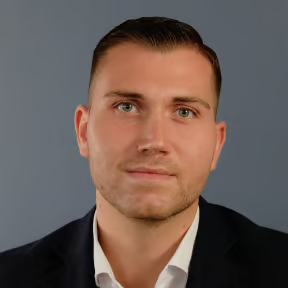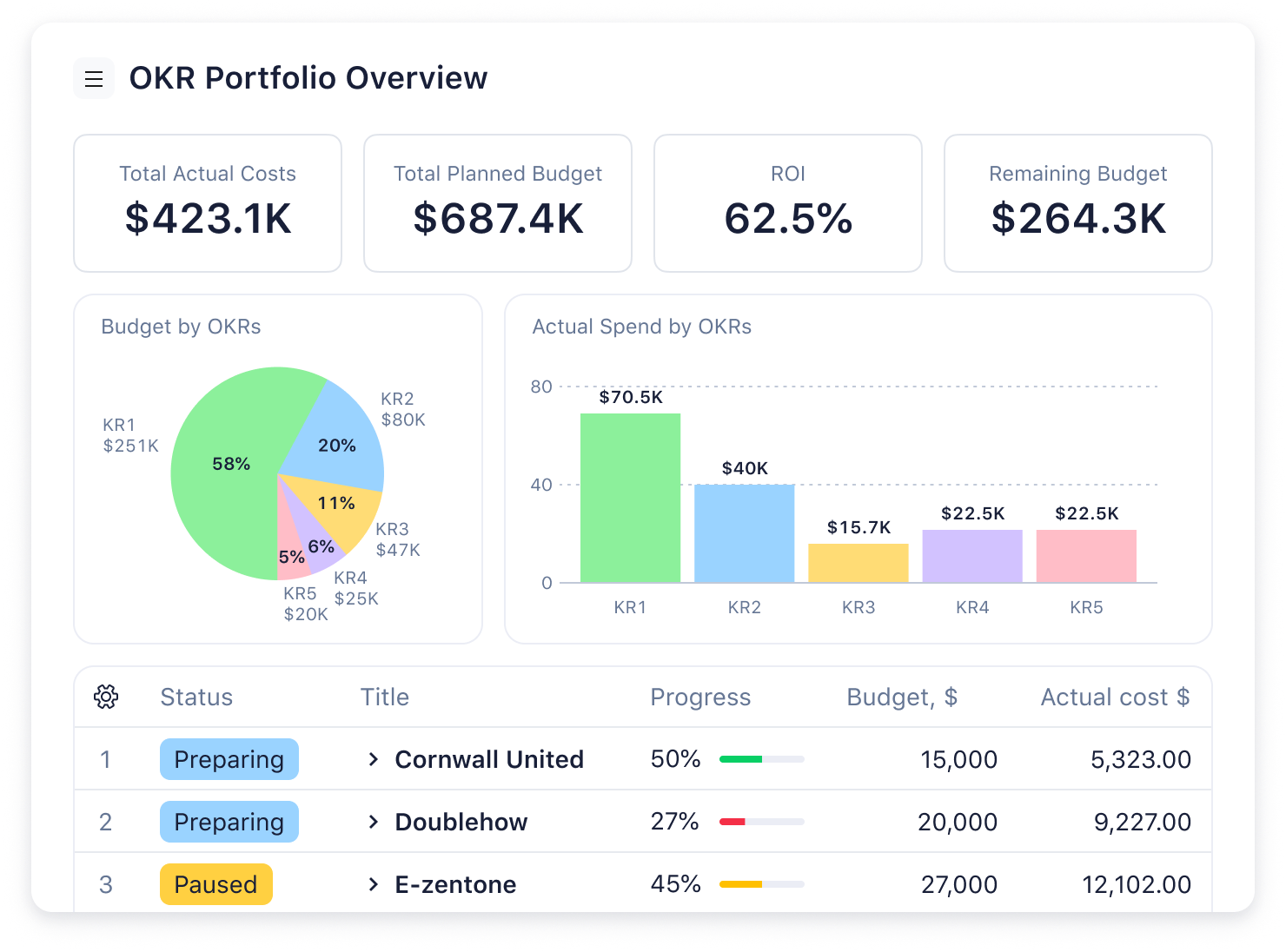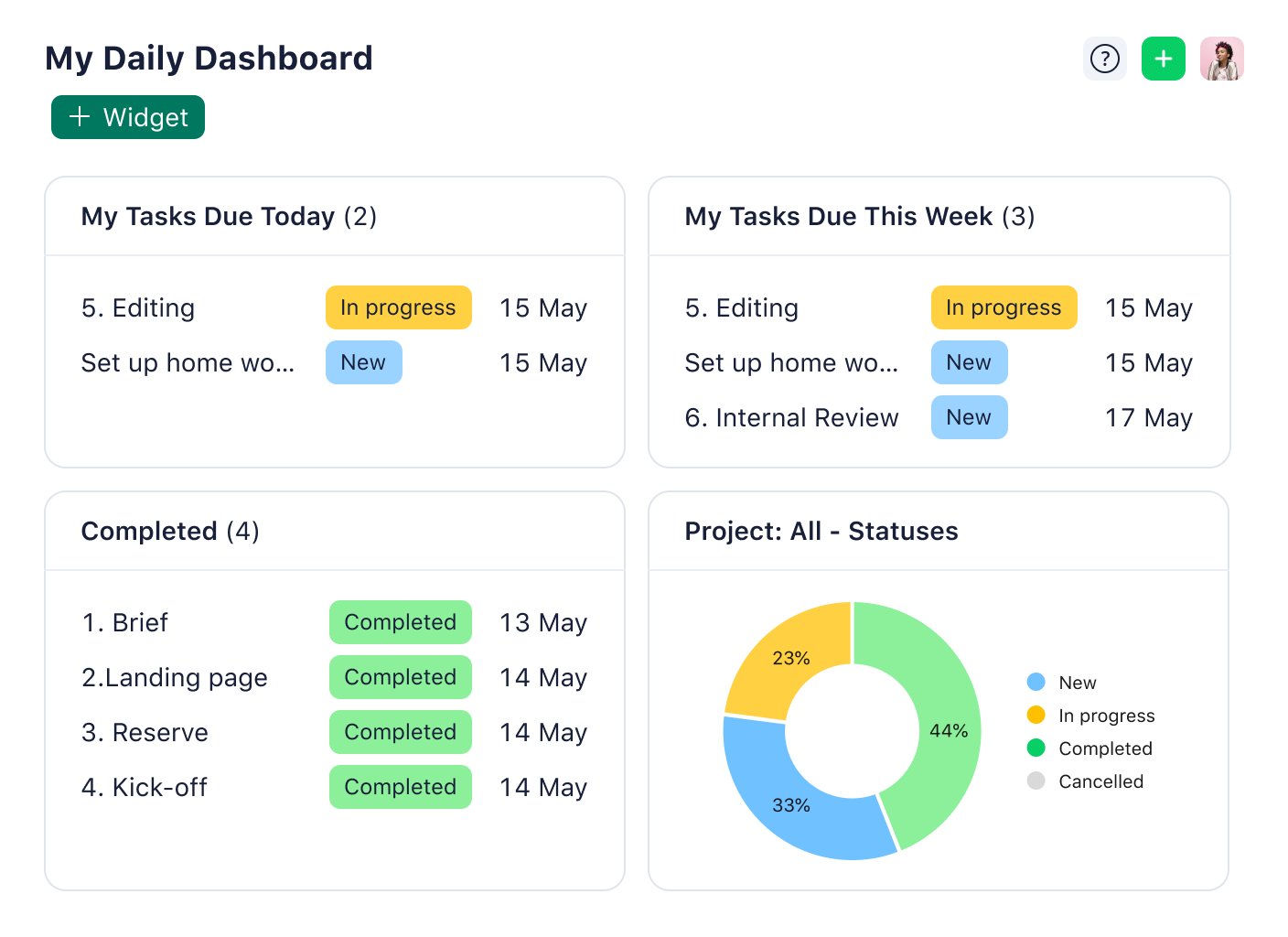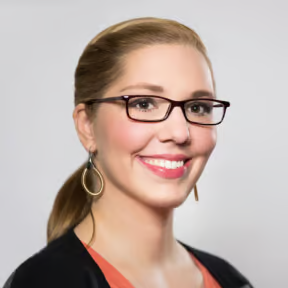Key takeaways:
- What is essential for enterprise project management tools? They must facilitate coordination across teams, provide visibility on project progress and resources, enhance accountability, and ensure security and integration with existing systems.
- Why is Wrike highly recommended for enterprises? Wrike offers robust, flexible features tailored for large-scale projects, earning a 4.5/5 score from Gartner and trusted by brands like Walmart and Siemens.
- How does Wrike improve project visibility? Wrike uses Gantt charts and Kanban boards, allowing tracking of progress, task dependencies, and resource availability all in one place.
- What do enterprises gain from using Wrike? Benefits include improved efficiency, reduced internal communication, personalized dashboards for team members, and automations that streamline workflows.
- Is Wrike secure and compliant for enterprise use? Yes, Wrike is GDPR, CCPA, and HIPAA certified, ensuring protection of sensitive project data and ease of data migration.
Most guides to enterprise project management software you’ll find online have the same clear weakness: they won’t speak to the features you actually need as an enterprise.
Rather, they’ll treat an enterprise’s needs like any old organization. As a result, they’ll recommend task and project management tools like Trello or Zoho Projects, which, in reality, just won’t cut it at the scale at which you’re operating.
Instead, in this guide, we’ll introduce you to five project management tools you can trust to handle your needs as an enterprise. Throughout, we’ll compare those tools to four factors large-scale organizations have in mind when searching for project management software.
We’ll start with Wrike, our intelligent work management platform used by enterprises including The Estée Lauder Companies, Walmart, Sony Pictures Television, Capgemini, and Siemens Smart Infrastructure. But first, let’s check out those factors enterprises need from their software, so that you can make an informed decision on your best fit.
4 factors that make truly enterprise-level project management solutions stand out
Any enterprise managing large tasks and teams will demand a lot from their project management software. To satisfy your needs, that software must be able to handle complex workflows.
In our experience, there are four key things enterprises need from their project management tool:
- It should let you coordinate projects across teams and agencies with a single tool. When you’re managing complex projects across various teams and agencies, tools like Excel and email just won’t be enough. For enterprises, it’s more efficient and manageable to connect your workflows in a single tool. That speeds up admin, reduces the number of software licenses, and keeps all information in one place.
- It should give you visibility over project progress, resources, and costs. Being able to track tasks and dependencies is a must for any project. However, reporting tools that report in detail on resources, costs, and efficiency are just as important for project managers and enterprise business leaders alike.
- It should improve accountability for every team member. The best enterprise project management solution should make it easy to assign tasks, understand who’s responsible for what, and identify where bottlenecks occur. Plus, team members should have clarity over everything they personally need to get on with their own work.
- It should be robust, compliant, secure, and integrable into their existing structures. Many project tools fail because they’re a pain to set up and are too rigid to support the way you want to work. It’s a fine balance, though, because at the same time robust security should be non-negotiable.
If the project management solution doesn’t fulfill these needs, it won’t be adequate for an enterprise. However, there are tools out there that will work for you.
Enterprise project management software solutions: Summary and comparison
Here’s our compilation of five options for your enterprise project management software needs, including rankings by Gartner Peer Insights for the Project Portfolio Management category.
|
Brand name |
Gartner® score |
Price |
Enterprises like it for its… |
Downsides |
|
Wrike |
4.5/5 Also, a leader in Gartner’s Magic Quadrant™ for Collaborative Work Management |
Pricing starts at $10 per user per month. Enterprise plans are customized to your needs. A free trial is available. Get in touch here. |
Robust, flexible, and secure project management, with visibility over all of your tasks, resources, and teams |
The customization process can take time to get you the best results. |
|
Smartsheet |
4.3/5 |
Pricing starts from $9 per user per month, to a maximum of 10 users. On top of advertised plans, there are many expensive add-ons. |
Spreadsheet-style visuals and project organization |
Smartsheet has many of the limitations of other spreadsheets, including the rigid sheet view and a lack of visibility over many projects at once. |
|
Adobe Workfront |
4.2/5 |
Pricing isn’t publicly available. |
Seamless integration with Adobe suite |
The software is difficult to customize. |
|
ClickUp |
4.2/5 |
Pricing starts from $7 per user per month. |
The huge range of features |
ClickUp is known for being very buggy, and there can be problems with stability at scale. |
|
Microsoft Project |
4.3/5 |
Pricing starts from $10 per user per month. |
Compliance, security features, and integration with Microsoft Office |
MS Project lacks many key features that other tools offer as standard. |
1. Wrike
Wrike is a project management platform built for enterprises. We’ve made it flexible enough so it can adapt to your organization’s way of working. But it’s also sufficiently robust to have every feature you need to make managing large projects more efficient and secure.
For instance, Electrolux, the appliance manufacturer employing over 50,000 people across the world, uses Wrike to cut time spent on each creative project by 30%. Similarly, Siemens uses Wrike to improve productivity by 10% across 14,000 users in 20+ countries.
What’s more, according to Gartner, Wrike is one of the highest-rated project portfolio management tools on the market. With a score of 4.5 out of 5, it beats competition from the likes of Monday.com, Asana, Smartsheet, and Adobe Workfront.
But how does Wrike’s enterprise work management software stack up against the features above?
1. Wrike unifies your whole project management process into one tool
Today, enterprises are using tens of different tools to manage projects. These range from Adobe Creative Cloud and Google Docs, to Slack and email, to documentation hubs like Notion or GitHub.
For the largest companies, working across multiple teams and agencies, this is a serious threat to efficiency. Plus, it means critical info gets scattered across tools, making it hard to find for every employee.
Wrike eliminates barriers by acting as a single source of truth for all your projects, deadlines, and workflows. With Wrike, work flows freely, enabling you to focus on achieving your project goals. This way, your teams can communicate, track progress and dependencies, and actually do their work all in the same place.
Wrike’s enterprise project planning software lets you do exactly that.
- Plan, track, and update projects and tasks in one place. Set up a single source of truth for all your projects and workflows, even if they’re across agencies, departments, and geographies.
- Communicate about work and tasks in the same software. You can reduce the number of emails and Slack messages you send by briefing, discussing, and giving feedback on tasks within Wrike. Even people who are external to your organization can use the tool to give feedback on your work.
- Automate key processes to make your workflows more efficient. Wrike comes with robust automation features that make life easier for everyone. For instance, simpler collaboration tools will just notify colleagues when a given task is complete. In contrast, Wrike lets you automate the entire workflow from start to finish. As soon as a piece of work is requested, Wrike sets up all the relevant dependencies and triggers, cutting inefficiency and ensuring nothing falls through the cracks.
- Identify other areas that could be more efficient. While you’re doing your work, Wrike’s AI tracks the repetitive tasks your team completes and suggests ways to automate them. It gives you additional opportunities to improve your performance.

Let’s take an example of how certain features of enterprise project management can drive efficiency. Intelco is an Italian software house that provides tailored services for large industrial groups of various kinds, from the motorway to the airport, engineering, retail, textile, and more.
The company brought on Wrike to help manage its large teams. Since onboarding the software, Intelco has reduced the number of internal emails by 90%. And teams spend 30% less time in project meetings.

With Wrike, we’re simplifying our work because, with a couple of clicks, we can backtrack on our activities to see previous communication or anything else we need to. That was one of the biggest goals Wrike helped us achieve — the whole company finally collaborating with each other.
Mattia Ronchi, Project Manager
2. Wrike gives you clear visibility on project progress and resources
Without an effective enterprise project management system, it’s easy to lose track of projects.
This isn’t just an abstract worry. If you don’t have visibility on how projects are progressing, you can miss deadlines or risk overspend on your budget. This carries concrete financial and reputational risks.
Instead, Wrike provides total clarity on the progress and cost of projects — and the capacity of staff — so you never lose track of a project again. Plus, thanks to our unique cross-tagging feature, Wrike helps you see how specific tasks impact other projects too.
- Track project progress, task statuses, and any bottlenecks effortlessly. With Wrike’s sophisticated Gantt charts, Kanban boards, and other visualizations, you’ll be able to see everything you need to know about a project. That means dependencies, project statuses, milestones, and more.
- Understand how tasks relate across multiple custom projects. Every project is different, and no enterprise handles just a single project at a time. With Wrike’s unique custom item types, you can create and organize your own folders, projects, tasks, and subtasks — entirely based on your own work structure. Then, you can use our cross-tagging feature to see how your task relates to other projects your teams are working on without duplicating the task itself.

- Understand colleague capacity and availability. With live charts and time tracking functionality, you can also get insight into what resources are available and what more you need to finish a project. Your timesheets can be automatically synced with your finance system for additional monitoring, invoicing, and more.
3. Wrike gives every project team member clarity on their tasks for added accountability
It’s not just leaders that need to know what’s going on across the organization. To collaborate well on projects, employees need to have clarity on their own workflows and tasks, understand what they need to do when, and see how their roles fit with colleagues’ tasks.
One of the key benefits of a robust project management tool like Wrike is that it gives every single person within your organization a personalized view of what they need to do each day. The result is better accountability and efficiency.
- Empower every team member with a personalized dashboard. Every Wrike user has their own custom dashboard, where they can see the tasks they need to prioritize and the dependencies they’re waiting on others for. They’ll have a unique perspective on their work, across all the projects they’re working on.

- Notify everyone automatically with tasks they need to complete. If new projects are requested or new tasks are ready to be actioned, every relevant person will be personally notified with a brief and due date. This way, team members don’t need to bring up a separate tool to explain to others what needs to be done.
- Ensure employees only see what they need to with robust access levels and permissions. Access permissions are set at the folder level, so you can trust that your assets and resources stay secure.
Before using Wrike, Capgemini, a French management consulting enterprise, was struggling to get complete visibility and assign active tasks.
“Since we had a decentralized system in place to gather and manage those requests, it was hard to understand what every team member was working on at any given moment. When I learned about Wrike, I realized how powerful this solution might be for solving our challenges,” says Dan Stevens, Director of Marketing Services.
Now, thanks to Wrike, Capgemini reports 95% on-time delivery and customer satisfaction.
I think it’s amazing to be able to have a tool that helps us collaborate, and to be surrounded by people that have the same vision and really want to get everything done, and done beautifully.
Dan Stevens, Director of Marketing Services
4. Wrike is secure, compliant, and easy to set up
Aside from providing flexible, intuitive features that enable you to plan projects and work more efficiently, enterprise project management tools need to do the basics well.
That means they need to securely protect critical and sensitive project information and personal data. But it also means that setup and any data migrations from existing tools need to be easy.
You’ll know well that any onboarding difficulties will put the brakes on adoption. That’s why, at Wrike, our professional services teams are with you throughout to securely migrate your data, set up your software, and customize it to your needs.
- Migrate your project data from previous tools quickly, securely, and easily. Our professional services team will make this simple. Or, if you’d prefer, you can do it yourself using XSL files.
- Trust our support teams to help you customize your workflows to get the best out of Wrike. Many enterprise tools will onboard customers and leave them to handle everything else themselves. Instead, our teams are there to make sure you have everything you need, through weekly calls and software training.
- Keep using business-critical tools alongside Wrike. Thanks to Wrike’s hundreds of integrations, you can easily use our project management tool alongside your existing software. For instance, you can use the Microsoft Office suite alongside Wrike, as well as your CRM or your communication tools. With Wrike, integrations are easy to use (and with no code, too), and you can set up automations across apps to streamline workflows effortlessly.
- Be reassured about your data privacy. Wrike is GDPR, CCPA, and HIPAA certified. You can find out more about our security features here.

Siemens is a Swiss technology company with dispersed international teams and a huge volume and scale of projects. The enterprise found that its disjointed tech setup was affecting team productivity and posing a security risk, and so it brought on Wrike.
“Security matters,” says Hannes Leitner, Process Owner of Project Execution at Siemens Smart Infrastructure. “Now, Wrike is aligned to our internal enterprise standards, and the users can add all their confidential data in Wrike without having to fear security breaches or compliance issues.”

Wrike offers some helpful, out-of-the-box features that are essential for enterprise use. We set up the dashboards so collaboration and task management work best across functional teams in branches. Custom workflows and conditional request forms also support and scale up to efficient work management in the regions. Additionally, the effort estimation in Wrike’s resource management is helpful. Changes in due dates or tasks are easily tracked and consolidated, supported by the Gantt chart view — which makes planning easy.
Christina Fischer, Global Product Manager
Wrike reviews
Wrike receives a score of 4.5 out of 5 from Gartner. Wrike was also named a leader in Gartner’s Magic Quadrant™ for Collaborative Work Management.
Wrike has a Capterra score of 4.3 out of 5, based on over 2,700 reviews.
Wrike pros
- Wrike is a tool built for enterprises that has all the traditional project management features you’ll need.
- Wrike boasts robust security and it’s easy to migrate all relevant data without hassle.
- Wrike gives you clear data for project planning, resource allocation, and budget tracking.
- Wrike is flexible, agile, and customizable, so you can build the workflows and projects you need.
Wrike cons
- Wrike can require some time to optimize its customizations.
Wrike pricing
Pricing starts at $10 per user per month. Enterprise plans are entirely customized to your organization’s needs.
If you want to try out Wrike before you start, a free trial is available. Get in touch here.
2. Smartsheet
Smartsheet is a project management software that’s based around the concept of a spreadsheet.
That makes it a great option for teams who are already used to spreadsheets. However, it’s a less good option if you actively want to move away from the spreadsheet format (as many enterprises do). You may find that Smartsheet replicates many of the features (and flaws) of a spreadsheet, which other software can liberate you from.
Smartsheet is good for enterprises in the sense that it scales well. Projects are shown as individual spreadsheets, and tasks are lines in that sheet. If you have multiple projects, all you need to do is add as many sheets as you need, and there’s no greater complexity at scale.
That said, you won’t have access to all of Smartsheet’s features — for instance, reporting — if you only pay for the standard plan. Instead, you’ll need to pay for additional add-ons to get value from the tool.
Smartsheet reviews
- Gartner score: 4.3/5
- Capterra score: 4.5/5, based on over 3,300 reviews
Smartsheet pros
- Smartsheet has a spreadsheet style that will be familiar to most employees.
- Smartsheet scales well to handle the largest projects.
Smartsheet cons
- Smartsheet’s spreadsheet format may be limiting for many users.
- Smartsheet doesn’t offer sophisticated analytics and reporting. It actually invites you to export data to Excel to analyze it there.
Smartsheet pricing
Smartsheet is priced using four different plans, with the enterprise plans offering a custom price based on your needs.
Be aware that Smartsheet plans don’t typically include everything you need for effective project management. Instead, the tool has many add-ons, meaning you might end up paying more than you originally intended.
Smartsheet also changed its user subscription model earlier in June, limiting what unlicensed, budget-conscious customers can do within the app. For instance, your team will only have access to three simplified user types, down from 10+ options.
3. Adobe Workfront
As it’s part of the Adobe family, it can make sense for teams and organizations that already use the Creative Cloud suite, such as design or marketing teams. However, you should be aware that it’s among the most expensive tools on this list (although you can get a discount if you’re an Adobe customer already).
One of the drawbacks of Workfront is its user interface. Customers often note that completing simple tasks requires a lot of complex navigation. Plus, it’s a surprisingly inflexible tool, with a very rigid structure that doesn’t allow for ad-hoc tasks.
Adobe Workfront reviews
- Gartner: 4.2/5
- Capterra: 4.4/5, based on over 1,400 customer reviews
Adobe Workfront pros
- Adobe Workfront is particularly strong for creative teams, as it seamlessly integrates with the rest of the Adobe Creative Cloud suite.
- Adobe Workfront scales well, as an enterprise tool should.
Adobe Workfront cons
- Adobe doesn’t offer a free trial, meaning that you can’t know for sure what you’re going to get.
- Adobe Workfront is not very customizable, with most configurations only modifiable by an admin.
Adobe Workfront pricing
Adobe Workfront doesn’t publicly share its pricing plans, nor does it offer a free plan. Instead, you’re invited to contact the team.
4. ClickUp
ClickUp is a well-known project management software solution. It’s a pretty flexible product that works well for teams of almost any size, structure, or complexity. While it’s not built specifically for enterprise teams, many large organizations do use it.
Part of ClickUp’s appeal is that it markets itself as the “one app to replace them all.” In practice, all this means is that it has a lot of different features. For instance, it has its own docs tool, Docs, where you can do work within the software itself, without the need for an integration.
But this wealth of features can be a double-edged sword. Not all of them are as reliable as they should be, particularly at scale. One of ClickUp’s clear benefits is that it’s really easy to set up, even at scale. But if you need some support, you won’t always get it. In fact, ClickUp has no phone support at all.
ClickUp reviews
- Gartner: 4.2/5
- Capterra: 4.6/5, based on over 4,300 reviews
ClickUp pros
- ClickUp is really easy to set up, even if you’re operating at enterprise level.
- ClickUp boasts a wide variety of features, meaning it can replace many of your tools if you want it to.
ClickUp cons
- Despite its numerous task views, ClickUp lacks the comprehensive PPM features needed to run a larger enterprise. Users will find it difficult to roll up data and provide executives with a high-level view of project progress.
- ClickUp’s reliability is an issue, with many features not always performing well.
- ClickUp’s support is lacking, with no phone support at all.
ClickUp pricing
ClickUp is free for the basic plan. For enterprise packages, you’ll have to contact the sales team.
5. Microsoft Project
Microsoft Project is Office’s own project management tool. Enterprises like it for its compliance, an area where Microsoft applications tend to be strong. It can be an attractive option if you’re already using the MS Office suite.
One thing to be aware of is that the MS Project tool by itself is quite limited. For instance, there is no option to see workload or demand across team members, while budget tracking is almost impossible across multiple projects. Overall, the dashboards and reporting are weak, with a lot of key features just not available.
This is because Microsoft assumes that you’ll be using MS Project alongside other (Microsoft) tools for collaboration, automation, and more. Of course, you can, but you’ll end up flicking between Microsoft Teams, Outlook, Word, and other Office tools to actually get any work done. Another issue to be aware of is that, like Teams, MS Project can be heavy, complex, and rigid. Don’t use it expecting a great user interface.
Microsoft Project reviews
- Gartner: 4.3/5
- Capterra: 4.4/5, based on over 1,900 reviews
Microsoft Project pros
- Microsoft Project seamlessly integrates with the entire Microsoft Office suite.
- Microsoft Project, like Teams, is strong when it comes to questions of security and compliance.
Microsoft Project cons
- Microsoft Project is really rigid and relies on integrations with other Office tools, a drawback for companies not fully embedded in the Microsoft ecosystem. For highly customizable workflows, efficient time tracking, and in-depth project analytics, Wrike comes out ahead.
- Microsoft Project lacks many features you’d expect from a project management tool, including proofing.
Microsoft Project pricing
Pricing starts from $10 per user per month and quickly rises to $55 per user per month for the enterprise package.
Choose Wrike for flexible, robust, and secure enterprise project management software
You’ve got the talent. You’ve got the tools. So why does it still feel so chaotic? Most project management tools just don’t work for enterprises. They’re built for smaller teams and simpler workflows. Wrike, on the other hand, scales with you as you grow.
In this guide, we’ve shared five options to choose from for your enterprise project management needs. Ultimately, try a free trial (if the software offers one) and pick the enterprise project management tool that best suits your needs.
With its flexible work structure, robust security, and powerful reporting features, Wrike’s EPM software offers everything you need to deliver projects more efficiently and successfully.
Contact us to set up a demo or start your free two-week trial.






